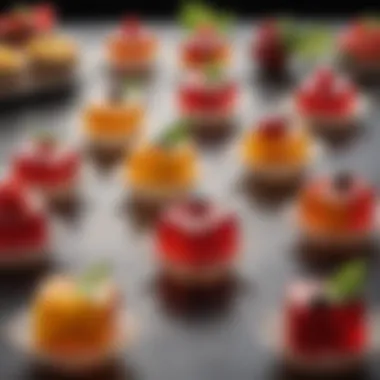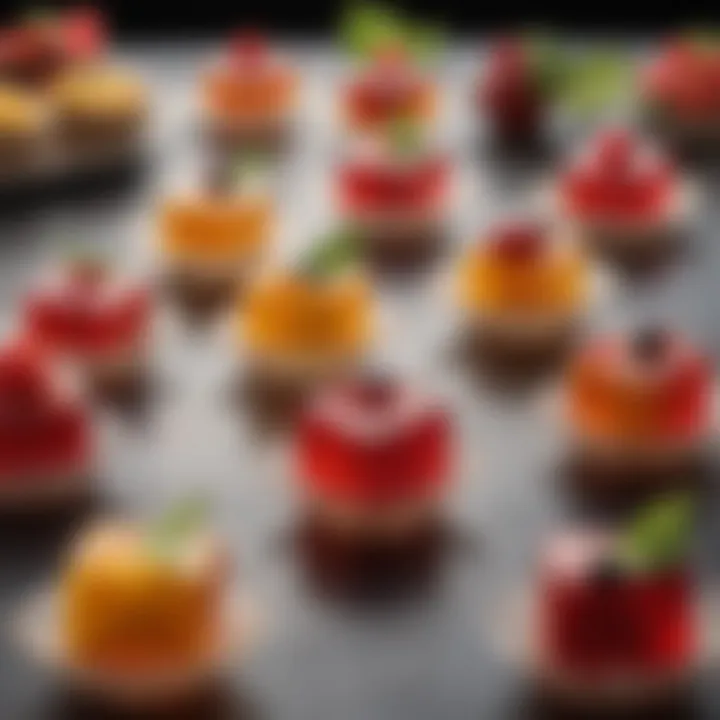Asian Jello Snacks: A Culinary Journey


Intro
Asian jello snacks are more than just sweet treats. They represent a blend of tradition and innovation, showcasing various textures, flavors, and cultural significance. With roots in numerous Asian countries, these desserts vary widely, reflecting the region's diverse culinary practices. From the delicate wobble of Mango Pudding to the vibrant hues of Grass Jelly, each variety tells a story of its own.
This exploration not only examines the preparations and ingredients used across the continent but also dives into the nutritional aspects and unique serving suggestions. Understanding these jello snacks can enhance one’s appreciation for the culinary arts of Asia and inspire cooks to incorporate these delightful desserts into their own kitchens.
Asian jello snacks are characterized by their ease of preparation and adaptability, making them perfect for any occasion. Whether served at a festive gathering or as a casual treat, they appeal to a wide audience. This article aims to demystify the process of creating these snacks and to celebrate their place in modern cooking.
Foreword to Asian Jello Snacks
Asian jello snacks represent a captivating blend of culinary traditions and contemporary flavors. Their significance is rooted not only in their unique textures and tastes but also in their vibrant cultural histories. Understanding these snacks is crucial for appreciating their role in Asian cuisine and their growing popularity worldwide.
The importance of Asian jello snacks extends beyond mere sustenance. They embody a celebration of community, often enjoyed during festivals and special occasions. Their various presentations—colorful layers, embedded fruits, or floral infusions—enhance their visual appeal and elevate the dining experience. Moreover, they offer a diverse repertoire, appealing to diverse palates while also catering to dietary restrictions.
In this initial section, we aim to explore the historical and cultural foundations of these snacks. This will provide valuable context for readers, enriching their understanding of how these delicacies evolved from traditional recipes to modern interpretations.
Historical Overview of Jello
The origins of jello can be traced back to ancient methods of gelatin extraction, where animal collagen was boiled to create jelly-like substances. Historical records suggest that various cultures used similar techniques, but it was not until the 19th century that jello became commercially viable.
In the West, the invention of packaged gelatin by Franz S. Gallatin in 1845 revolutionized the dessert industry. The simplicity of preparation coupled with the appealing texture made it widely popular. However, in Asia, gelatin alternatives existed long before this, often derived from local plants. These traditional methods are still prevalent today, giving Asian jello snacks their distinct characteristics.
Cultural Origins of Asian Jello Snacks
Asian jello snacks find their roots in various cultural practices across the continent. In Japan, for instance, the utilization of kuzu (a starch from the root of the kudzu plant) has been practiced for centuries. This method showcases how natural ingredients play a vital role in creating textured desserts.
Similarly, in Southeast Asia, agar-agar, derived from red algae, is a favored ingredient. Its vegetarian properties make it desirable for many, allowing for the creation of delightful snacks that align with diverse dietary needs. Local fruits and herbal infusions are frequently incorporated, resulting in flavors that celebrate regional produce.
In summary, the cultural significance of these snacks is immense. They not only fulfill a culinary purpose but also serve as a means of connection among communities during celebrations and gatherings. Understanding their origins allows food lovers to appreciate the stories and traditions they carry, inviting them to explore their own culinary creativity.
Key Ingredients in Asian Jello Snacks
The key ingredients in Asian jello snacks play a vital role in defining their unique taste, texture, and cultural significance. These components not only enhance flavor but also contribute to the overall experience of these delightful treats. From alternatives to traditional gelatin to the diverse flavors sourced from nature, each ingredient serves its purpose in creating a medley of sensations that Asian jello snacks are known for.
Agar-Agar: The Vegetarian Gelatin Alternative
Agar-agar is a well-known vegetarian substitute for gelatin. Its origin dates back to the Japanese and has now spread widely throughout Asia. It is derived from red algae, making it a suitable choice for those who follow a vegan or plant-based diet. The process of extracting agar-agar involves boiling the algae and then cooling it to form a gelatinous substance, which can be further processed into powder or bars.
The significance of agar-agar lies in its gelling properties. It sets more firmly than traditional gelatin, which may result in a slightly different mouthfeel. Many people prefer this texture, especially in desserts, as it provides a satisfying bite. Furthermore, agar-agar is heat-stable, allowing it to maintain its shape even in warmer conditions. This characteristic makes it an ideal ingredient for various Asian jello creations, as it can be molded into intricate shapes without losing integrity.
Flavors Derived from Fruits and Plants
Traditional Fruits
Traditional fruits are a cornerstone in the world of Asian jello snacks. These fruits contribute natural sweetness and vibrant colors, enhancing the visual appeal of the final dish. Common examples include mango, lychee, and passionfruit. These fruits not only add flavor but are also packed with vitamins and antioxidants, making them a nutritious addition.


One key characteristic of traditional fruits is their aroma. The fragrance of ripe fruit can evoke memories and emotions, increasing the pleasure of consuming these snacks. For instance, mango offers a tropical taste that many people find refreshing. The use of traditional fruits aligns with a health-conscious trend, appealing to those seeking less processed options. However, there is a consideration — some fruits, like bananas, may produce excess liquid or change texture when combined with agar or jelly, which requires careful handling during preparation.
Herbal Infusions
Herbal infusions in jello snacks provide an interesting twist and depth of flavor. Ingredients like green tea, pandan leaves, or jasmine can elevate the experience. These herbs often have cultural significance and are believed to offer health benefits. For instance, green tea contains antioxidants and is reputed to aid digestion.
A critical characteristic of herbal infusions is their subtlety. Unlike fruity flavors, which tend to be more assertive, herbs contribute a more delicate taste profile. This balance allows for creative experimentation in recipes, enabling chefs to develop unique combinations. However, balancing these flavors is key, as overpowering herbal notes can overpower the sweetness of the jello itself.
Sweeteners and Their Variations
Sweeteners play an essential role in Asian jello snacks, impacting flavor and texture. Early iterations may have relied on cane sugar, but today a variety of sweeteners are in use. Natural options like honey or palm sugar are popular for their rich flavors and health benefits.
The choice of sweetener can significantly affect the final taste. For example, palm sugar brings a caramel-like sweetness that complements tropical flavors. Some recipes may also include sweeter options such as sweetened condensed milk, which can add creaminess to jello.
Different sweeteners may introduce a range of textures as well. Using honey can create a smoother consistency, while granulated sugar might contribute more to the graininess of the final product. It's important to experiment with the ratios, as sweeteners not only impact taste but can also change the gelling properties of agar-agar or any other base used.
"The wide range of ingredients used in Asian jello snacks reflects the cultural diversity and culinary creativity found across Asia."
In summary, the key ingredients in Asian jello snacks are chosen with precision, each contributing to the overall dish. Whether it’s the sturdy agar-agar that provides structure, the vibrant traditional fruits that add natural sweetness, the delicate herbal infusions that provide depth, or the various sweeteners that balance the flavors, every aspect of the ingredient selection is crucial. These elements make Asian jello snacks not only delightful to consume but also rich in cultural heritage.
Types of Asian Jello Snacks
The category of Asian jello snacks is diverse and fascinating, showcasing the creativity found across different cultures. This section focuses on unique jello varieties, how they reflect regional tastes, and why they matter in the culinary landscape. Each type of snack brings its own cultural significance and preparation methods, enriching our understanding of this genre. Furthermore, learning about these variations presents an opportunity for culinary exploration and enjoyment, encouraging food lovers to incorporate diverse flavors into their own kitchens.
Mizu Shingen Mochi: The Water Cake
Mizu Shingen Mochi is a notable example of a traditional Japanese dessert. This delicacy is often referred to as the "water cake" due to its transparent appearance made possible through the use of high-quality water and agar-agar.
The texture is incredibly unique. Unlike standard jello, Mizu Shingen Mochi has a soft and delicate structure that gently melts in the mouth. It is typically served with a drizzle of sweet soy sauce or syrup, adding a balanced flavor that complements its understated sweetness. This snack is more than just a treat; it reflects the Japanese philosophy of incorporating natural elements into food.
Culinary enthusiasts and professionals alike appreciate the authenticity and craftsmanship involved in preparing Mizu Shingen Mochi. Making it requires precision, and attention to detail enhances the overall culinary experience.
Thai Coconut Jelly: A Tempting Variation
Thai Coconut Jelly, also known as Woon Maphrao, is a dessert that encapsulates the tropical essence of Thailand. Made primarily from coconut milk and agar-agar, it delivers a rich flavor and smooth texture that many find irresistible.
This dessert is often layered with variations infused with pandan leaves, adding both color and a subtle fragrance to the dish. The use of coconut makes it a notable go-to snack during warm weather. The combination of the creamy coconut with the slight bounce of agar offers a unique mouthfeel.
Moreover, Thai Coconut Jelly serves as an excellent base for creativity. One can easily adapt the recipe by adding fruits like mango or lychee, expanding its appeal. As such, it fits perfectly with many occasions, from casual gatherings to festive celebrations.
Vietnamese Jelly Desserts: A Sweet Delight
Vietnamese jelly desserts are a vibrant and colorful addition to Asian jello snacks. Known for their variety, these desserts often incorporate layers of jelly, fruit, and sometimes coconut milk, creating an attractive presentation that is pleasing to the eye.
Commonly enjoyed during special occasions, they encompass flavors from local fruits, such as jackfruit and longan. The base may vary, but agar-agar is frequently used, aligning with healthier eating trends that have gained traction in recent years.
Vietnamese jelly desserts also emphasize the beauty of texture, with a mix of soft and chewy components. Each layer not only brings its own distinct flavor but also contributes to a well-rounded experience. This dessert highlights the importance of presentation in Vietnamese culture and provides enjoyment in both making and savoring.
Preparation Techniques for Jello Snacks
Understanding the preparation techniques for jello snacks is essential for anyone interested in creating these delectable treats. Various methods impact the final product, influencing not just the taste, but also the texture and presentation. Knowing the nuances of these techniques aids cooks in making the most of the ingredients, leading to a more satisfying end result. This section breaks down key methods in making jello snacks, focusing in detail on their importance and practical considerations.
Basic Jello Making Process
The basic jello making process is relatively straightforward, yet it requires precision to ensure the best outcome. Begin by gathering ingredients, which typically include agar-agar, water, sweeteners, and flavors. Heating the water until it begins to boil is vital; this activates the gelling agent. Once boiling, incorporate the agar-agar, stirring consistently to fully dissolve it. The mixture should simmer for a few minutes to enhance the texture.
After dissolving, remove the pot from heat and allow it to cool slightly before adding any delicate flavors or sweeteners. Pour the mixture into desired molds. It is crucial to let it set undisturbed in the refrigerator for several hours. The setting time can greatly impact the final texture, so patience is key here. A well-made jello should be firm yet slightly wobbly when removed from the mold, an indication that it has set properly.


Key steps for the basic jello making process:
- Gather ingredients: agar-agar, water, sweeteners, and fruit juices.
- Heat water to boiling point.
- Dissolve agar-agar by stirring in the boiling water.
- Remove from heat, let it cool slightly, and add flavors or sweeteners.
- Pour into molds and place in the refrigerator to set.
Incorporating Textures: From Creams to Toppings
Incorporating textures into jello snacks can elevate them beyond a simple dessert. Adding creams, fruits, or other toppings not only enhances flavor but also creates visual appeal. This technique is about layering textures to offer a delightful eating experience.
Start with a base layer of jello. Once it has partly set but is still slightly tacky, add additional ingredients. For example, a thin layer of coconut cream can be spread on top before the jello fully solidifies. This not only creates a creamy contrast but also adds rich flavor. Fresh fruit pieces can also be embedded within the jello for bursts of sweetness and nutrition. Choose fruits that complement the flavors of the jello to achieve balanced taste.
To finish off your jello snacks, consider sprinkling some toasted nuts or seeds on top or drizzling with syrup. These additions provide crunch and can make each bite more intriguing.
Important considerations when incorporating textures:
- Ensure base layer is partially set to hold toppings.
- Select toppings that complement base flavors.
- Experiment with different textures like creams, fruits, and nuts.
Incorporating textures in jello snacks enhances both flavor and presentation, making them more enjoyable for all.
Nutritional Aspects of Asian Jello Snacks
Understanding the nutritional aspects of Asian jello snacks is vital for anyone interested in a balanced diet. These delightful treats combine various ingredients, often with unique health benefits. This section will explore caloric considerations and health benefits of key ingredients that make them appealing not only for their taste but also for their nutritional value.
Caloric Considerations
When evaluating the caloric content of Asian jello snacks, it is useful to consider both the ingredients used and the portion sizes. Generally, snacking on jello provides a low-calorie alternative to many dessert options. For example, typical jello made with agar-agar can have significantly fewer calories than traditional gelatin made from animal products.
Here are some points regarding the caloric aspects:
- Agar-agar is low in calories: Since it is derived from algae, agar-agar typically has around 10 calories per serving, making it a suitable option for those watching their intake.
- Natural sweeteners vary in calories: If sugar is substituted with natural sweeteners or fruit juices, the calorie count can be further reduced. For instance, using dates or honey instead of refined sugar might alter the total caloric value but still keep it relatively low.
- Portion sizes affect total calorie count: It is essential to consider how much of the snack you are consuming. A smaller serving can keep calories to a minimum and provide a light, refreshing treat without significant guilt.
Health Benefits of Key Ingredients
The ingredients used in Asian jello snacks often contribute valuable health benefits. For instance, the use of fruits, natural sweeteners, and plant-based gelling agents ensures that the snacks are nutrient-dense. Here are some benefits:
- Agar-agar provides dietary fiber: This ingredient not only acts as a gelling agent but also adds fiber to the diet. Fiber is crucial for digestive health and can help maintain a feeling of fullness longer.
- Fruits offer vitamins and minerals: Key ingredient fruits bring in various vitamins such as Vitamin C from tropical fruits like mango and lychee. These nutrients are vital for maintaining overall health.
- Herbal infusions can have calming effects: Certain herbs added to the jello, like chamomile or mint, are known for their soothing properties, improving digestive health and potentially aiding relaxation.
- Natural sweeteners provide added nutrients: Sweeteners like honey or agave syrup often contain antioxidants, contributing additional health benefits compared to refined sugars.
These snacks not only satisfy sweet cravings but can also be a smart addition to a healthy diet, depending on the ingredients used and how they are prepared.
Serving Suggestions
Serving suggestions for Asian jello snacks are vital when considering their culinary value and versatility. The act of serving can transform a simple treat into a memorable culinary experience. Factors like the setting, the presentation, and complementary dishes play a significant role in how these snacks are perceived and enjoyed. Understanding various serving suggestions can elevate gatherings, formal events, or casual get-togethers.
Occasions to Serve Jello Snacks
Asian jello snacks serve well on various occasions. They are perfect for celebrations such as birthdays, weddings, and festivals. Their aesthetic appeal and unique flavors make them a favorite among guests.


A few specific occasions include:
- Festive Seasons: During holidays like Lunar New Year, these snacks symbolize good fortune and joy.
- Family Gatherings: They serve well as a refreshing dessert option at summer barbecues or holiday dinners.
- Café Menus: Many cafés feature these items as seasonal specialties, attracting patrons looking for something different.
Incorporating jello snacks allows hosts to provide a visual and palate-pleasing experience. Their diverse flavors cater to various tastes, ensuring everyone finds something appealing.
Pairing with Other Dishes
Pairing Asian jello snacks with complementary dishes can enhance a meal's overall experience. The delicate flavors of jello can balance heavier and spicier foods, creating a well-rounded menu.
Consider the following pairings:
- Savory Dishes: Serving jello sweets alongside fried or grilled dishes like Korean BBQ can create a beautiful contrast.
- Fruits and Salads: Light, fresh options such as fruit salads or refreshing greens provide balance and freshness that pairs well with the sweetness of jello.
- Beverages: Teas, especially jasmine or oolong, are great companions. Their fragrant notes enhance the overall experience of enjoying jello snacks.
Ultimately, thoughtful pairing and serving techniques not only enhance the flavors of the jello snacks but also elevate the dining experience.
Innovative Variations of Asian Jello Snacks
The realm of Asian jello snacks continually evolves. This evolution is significant as it blends traditional methods with modern culinary creativity. By exploring innovative variations, we appreciate how these snacks can adapt to new trends and preferences. This transformation encourages both established chefs and home cooks to explore unique flavors and presentations.
Fusion Recipes Incorporating Global Flavors
Fusion recipes stand out as a defining trend in the culinary world. For Asian jello snacks, this means integrating flavors and techniques from different cultures. Examples include:
- Mango Sago Jello: Combining the tropical sweetness of mango with elements of coconut milk and tapioca pearls, giving a creamy texture and vibrant flavor.
- Matcha Green Tea and Tiramisu Layers: Merging Japanese matcha with Italian tiramisu flavors offers a unique jello dessert that is both visually appealing and delicious. This blend retains the richness of the tiramisu while providing a unique twist.
- Spiced Chai Infusions: Adding traditional Indian chai spices such as cardamom and cinnamon to jello brings warmth and depth.
These types of fusion recipes encourage creativity while still respecting the original essence of Asian jello snacks. Cooks can adapt based on regional ingredients or personal preferences, making them truly versatile.
Creative Presentation Styles
The aesthetic appeal of jello snacks plays a crucial role in their reception. Creative presentation elevates the dining experience and emphasizes the uniqueness of each dish. Here are some strategies:
- Layering Techniques: Creating visually striking layers of different colors and flavors can make the dessert eye-catching. For instance, alternating layers of coconut jello and pandan paste can create a stunning visual experience.
- Using Unique Molds: Molds shaped like fruits, flowers, or even geometric shapes can enhance the presentation. This adds an element of surprise and creativity that can captivate anyone enjoying the treat.
- Garnishes: Fresh fruits, edible flowers, or herbs can be placed on top before serving. This not only adds flavor but also visual appeal.
In summary, innovative variations of Asian jello snacks allow for reinvention. By incorporating global flavors and enhancing presentation, cooks and chefs can provide a delightful experience. This section highlights their potential in today's culinary landscape.
The End: The Allure of Asian Jello Snacks
Asian jello snacks present a unique fusion of traditional flavors and modern culinary creativity. In this exploration, the intricate balance between texture, flavor, and presentation emerges as a central theme. They are not merely desserts, but cultural artifacts, reflecting the identity and history of the regions from which they originate. This significance highlights the importance of Asian jello snacks in contemporary gastronomy.
Revisiting Traditional Snacks Trends
As food trends evolve, there’s a growing interest in rediscovering and celebrating traditional snacks. Asian jello snacks, with their rich history and distinctive ingredients, align seamlessly with this movement. They offer an opportunity to blend dietary practices with cultural storytelling. Traditional recipes are being revitalized, allowing new generations to connect with their heritage. Techniques such as using agar-agar for a vegetarian-friendly gelatin option have added layers of versatility, ensuring these snacks appeal to modern tastes.
The revival of traditional desserts not only preserves culinary heritage but also promotes sustainability. By utilizing locally sourced ingredients, the making of Asian jello snacks can be environmentally considerate.
Encouraging Home Preparation
Encouraging individuals to prepare Asian jello snacks at home is essential for fostering a deeper appreciation of this culinary art. Home preparation allows for experimentation with flavors and textures based on personal preferences. The process can be both educational and rewarding; it invites cooks to engage with traditional methods and ingredients. Furthermore, with easily accessible recipes and tutorials available online, individuals can confidently explore and recreate these snacks in their own kitchens.
- Promotes creativity: Home cooks can customize ingredients based on dietary needs.
- Fosters family involvement: It encourages shared cooking experiences among family members.
- Enhances understanding of flavors: As cooks experiment, they gain a better grasp of how various components interact.
Ultimately, the allure of Asian jello snacks lies in their unique ability to transcend mere sustenance. They embody a celebration of culture and innovation, making them a delightful addition to any culinary repertoire.







